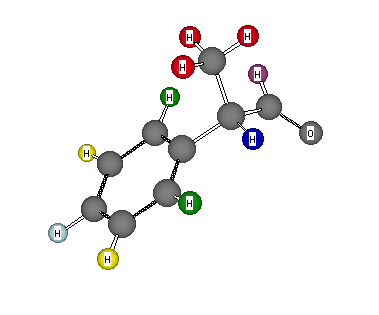Formula: C9H10O
Answer: 2-Phenypropionaldehyde
Chemical Shift Assignments:
1H NMR: δ 9.65 (1H, d, J = 1.2 Hz), 7.39 (2H, tt, J = 8.0, 1.6 Hz), 7.31(1H, tt, J = 8.0, 1.6 Hz), 7.23 (2H, dt, J = 8.0, 1.6 Hz), 3.61 (1H, qd, J = 7.2, 1.2Hz), and 1.45 (3H, d, J = 7.2 Hz)
13C NMR: 200.6, 137.7, 128.9, 128.2, 127.3, 52.5, and 14.2 ppm.
The degree of unsaturation is 5. The doublet at δ 9.65 is an aldehyde hydrogen coupled by 1.2 Hz to the methine hydrogen at δ 3.61. The larger coupling to this hydrogen (quartet, J = 7.2 Hz) is to a methyl group. The presence of the aldehyde is corroborated by the singlet at 200.6 ppm in the 13C NMR spectrum. All that has not been assigned is the residue C6H5-, which accounts for the remaining four degrees of unsaturation. It is a phenyl group. The para hydrogen integrates for a singlet hydrogen. It appears at δ 7.31 as a triplet (J= 8.0 Hz, ortho coupling to the meta hydrogens) of triplets (J = 1.6 Hz, meta coupling to the ortho hydrogens). The two hydrogens in the meta position at δ 7.39 are also a triplet of triplet for the same reason. The ortho hydrogens at δ 7.23 appears as a triplet of doublets (J= 8.0 Hz, ortho coupling to the meta hydrogen); J = 1.6 Hz, meta coupling to the para hydrogen.) The 13C NMR displays four aromatic carbons with the weak signal at 137.7 ppm being the ipso carbon. The least intense signal (127.3 ppm) of the remaining three aromatic singlets is presumably the para carbon. Assign the chemical shifts of the ortho and meta carbons based upon the the absorptions in toluene (1) below. Return to Menu.
 |
oxygen-yellow
|
|---|